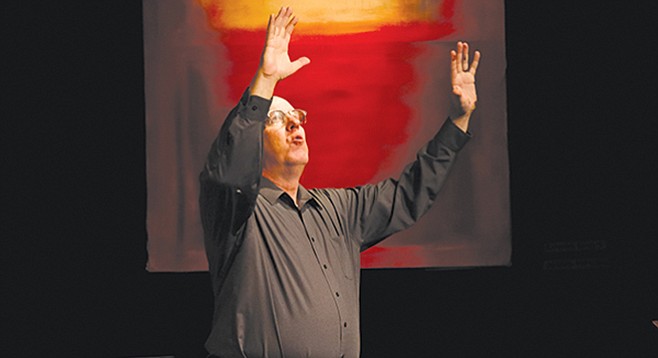 Facebook
Facebook
 X
X
 Instagram
Instagram
 TikTok
TikTok
 Youtube
Youtube

“I wonder if they will forgive me?” painter Mark Rothko asks towards the end of Red. “They” are his paintings, and what he needs forgiveness for is hanging them in the posh Four Seasons restaurant in NYC, where they will have to endure the indignity of enduring the presence of the glitterati, with their bourgeois tastes and opinions.
He defends his decision to send them there (and accept a fat commission check) by saying that the paintings will be able to “talk to each other.” He hopes that their very presence will kill the appetites of the restaurant’s patrons and make them reevaluate their shallowness and materialism.
That’s a lot to ask of some paintings, but Rothko believes his paintings are living, pulsing, communicating beings.
I’ve never seen a Rothko painting in person. Maybe they do “pulse” with meaning as he says. In any case, Rothko’s belief that his art was alive didn’t come across as creepy in the Pygmalion sense: he didn’t want to make love to his own creation.

Rather, it made me think of Mary Shelley’s Frankenstein. It seems to me that both Rothko (as portrayed here) and Percy Bysshe Shelley (Mary’s husband, and the thinly-veiled Victor Frankenstein) aspired to be all-powerful, all-creative — not beholden to any higher power, not needing other people for their creation. In other words, gods.
Given the opportunity to marry his childhood sweetheart and have a family, Victor utterly rejects that option. Creating life by cooperating with a woman and nature isn’t enough for him. He wants to be an absolute creator. He succeeds in creating life, but he rejects it in horror, believing his creation is subhuman rather than superhuman as he expected.
Rothko is a much more sympathetic figure than Shelley, so perhaps the comparison is a bit stretched. He was a Russian Jew who immigrated to the US as a child. He suffered great hardships during his life, rejected faith in G-d, and had no children. Perhaps, as a recluse nearing the end of his life, he needed to believe that he’d left a living legacy in his paintings.
I hope to see a Rothko in person someday, to see if it really does begin to pulse with life when gazed upon.


“I wonder if they will forgive me?” painter Mark Rothko asks towards the end of Red. “They” are his paintings, and what he needs forgiveness for is hanging them in the posh Four Seasons restaurant in NYC, where they will have to endure the indignity of enduring the presence of the glitterati, with their bourgeois tastes and opinions.
He defends his decision to send them there (and accept a fat commission check) by saying that the paintings will be able to “talk to each other.” He hopes that their very presence will kill the appetites of the restaurant’s patrons and make them reevaluate their shallowness and materialism.
That’s a lot to ask of some paintings, but Rothko believes his paintings are living, pulsing, communicating beings.
I’ve never seen a Rothko painting in person. Maybe they do “pulse” with meaning as he says. In any case, Rothko’s belief that his art was alive didn’t come across as creepy in the Pygmalion sense: he didn’t want to make love to his own creation.

Rather, it made me think of Mary Shelley’s Frankenstein. It seems to me that both Rothko (as portrayed here) and Percy Bysshe Shelley (Mary’s husband, and the thinly-veiled Victor Frankenstein) aspired to be all-powerful, all-creative — not beholden to any higher power, not needing other people for their creation. In other words, gods.
Given the opportunity to marry his childhood sweetheart and have a family, Victor utterly rejects that option. Creating life by cooperating with a woman and nature isn’t enough for him. He wants to be an absolute creator. He succeeds in creating life, but he rejects it in horror, believing his creation is subhuman rather than superhuman as he expected.
Rothko is a much more sympathetic figure than Shelley, so perhaps the comparison is a bit stretched. He was a Russian Jew who immigrated to the US as a child. He suffered great hardships during his life, rejected faith in G-d, and had no children. Perhaps, as a recluse nearing the end of his life, he needed to believe that he’d left a living legacy in his paintings.
I hope to see a Rothko in person someday, to see if it really does begin to pulse with life when gazed upon.
Comments